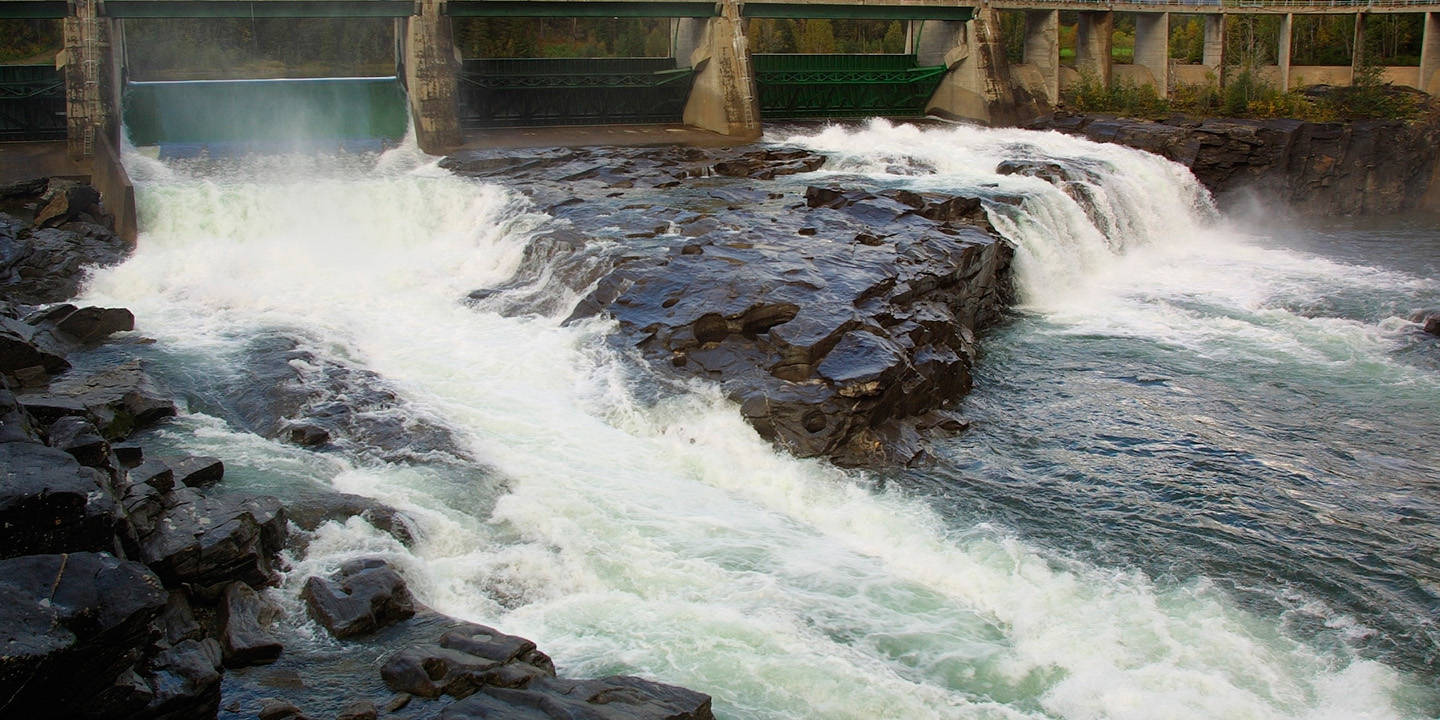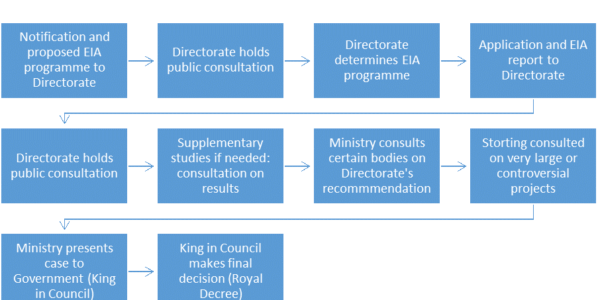The licensing authorities are responsible for processing licence applications and issuing licences. They include the Storting (Norwegian parliament), the Norwegian Government (formally the King in Council), the Ministry of Energy, the Norwegian Water Resources and Energy Directorate as well as municipalities. The text below describes licensing procedures for hydropower projects under the Watercourse Regulation Act and the Water Resources Act, and for electrical installations under the Energy Act.
There are some differences between the licensing procedures for large- and small-scale hydropower projects. Small-scale projects are defined as power plants that require a licence under the Water Resources Act and have an installed capacity of less than 10 MW, but do not involve regulation of the rate of flow in a river exceeding the limit that triggers licensing requirements under the Watercourse Regulation Act. Large-scale projects are power plants that require a licence under the Water Resources Act and have an installed capacity greater than 10 MW, and projects that regulate the rate of flow in a river and require a licence under the Watercourse Regulation Act.
The Norwegian Water Resources and Energy Directorate has prepared guidelines (in Norwegian only) for the administrative procedures for a number of different types of installations in river systems. These include aquaculture facilities, the construction of small power plants, upgrades and renovation of existing power plants, construction in or across river systems, gravel pits and flood protection measures.
The King in Council formally awards licences for projects dealt with under the Watercourse Regulation Act and for projects with an installed capacity exceeding 10 MW that require a licence under the Water Resources Act. The Norwegian Water Resources and Energy Directorate is responsible for procedures during the application phase.
In addition, under Norway’s regulations on environmental impact assessment (EIA), an EIA is mandatory for power plants with an annual production exceeding 40 GWh. For other installations, an EIA is required if the project may have significant effects on the environment and society. Norway has two sets of regulations that implement EU rules on environmental impact assessment. Hydropower projects come under the Regulations relating to environmental impact assessment of projects under sectoral legislation (referred to as the EIA Regulations here).
If a project comes under Appendix II of the EIA Regulations, an EIA is not mandatory and the developer is not required to notify the authorities of the project. As a general rule, the ordinary licensing procedures under the Watercourse Regulation Act and the Water Resources Act are followed in such cases. If an EIA is found to be necessary, it must satisfy the requirements of Appendix IV of the EIA Regulations. The developer may be required to submit supplementary studies if the application does not provide sufficient information. The impacts of a project must be thoroughly described in the application even if no EIA is required under the Regulations.
If a project comes under Appendix I of the EIA Regulations, so that an EIA is mandatory, the Directorate will determine the final impact assessment programme after submitting it to the Ministry of Climate and Environment. The notification is made available for public inspection and local authorities and organisations are consulted on its contents. They also receive a copy of the final assessment programme for information purposes. Once an EIA is completed, the report is submitted together with the licence application.
Authorities, organisations and landowners that will be affected by the project are consulted on the application, and the EIA if one has been carried out. The Directorate makes an overall assessment of the project and submits a recommendation to the Ministry of Energy. The Ministry prepares the case for the Government (King in Council) and presents its recommendation. This is based on the application, the Directorate’s recommendations, the views of affected ministries and local authorities and the Ministry’s own assessments. The King in Council then makes a formal decision on the project in the form of a Royal Decree. If a project is particularly large (more than 20 000 natural horsepower) or controversial, the Storting is consulted and given an opportunity to debate the matter before a licence is formally awarded by the King in Council. The figure below illustrates the procedures.
Decisions to grant licences for major development projects cannot be appealed, as the licensing authority rests with the King in Council. Decisions to refuse licences are made by the Ministry of Energy and can be appealed to the King in Council.
Licensing authority for small-scale hydropower projects has been delegated to the Directorate. Small-scale projects are defined as power plants that require a licence under the Water Resources Act and have an installed capacity of less than 10 MW, but do not involve regulation of the rate of flow in a river exceeding the limit that triggers licensing requirements under the Watercourse Regulation Act. The procedures are simpler than those for large-scale projects, which also means that they can be processed more quickly.
In June 2007, the Ministry published guidelines for small hydropower plants. They describe how to draw up regional plans for small hydropower plants and how to ensure comprehensive assessment of applications and make licensing procedures more efficient and predictable.
For power plants of between 1 and 10 MW, a study of biodiversity that may be affected by the development is required. Pursuant to the rules of the Planning and Building Act, public notice of the application is given in the local media, it is made available public inspection, and authorities, organisations and landowners that will be affected are consulted. After this, an on-site inspection of the area is held before a decision is made.
Decisions by the Directorate may be appealed. If the Directorate upholds its decision, the appeal is sent to the Ministry, which deals with it under the normal rules of the Public Administration Act. The Ministry’s decision is final and cannot be appealed. The figure illustrates the procedures.
The municipalities are the licensing authority for power plants below 1 MW (mini and micro power plants), with the exception of projects in protected river systems. All applications for such power plants are therefore first sent to the Directorate to decide how the specific application is to be processed.
Licensing authority
The Energy Act requires anyone who builds, owns or operates an installation for the production, transformation, transmission or distribution of electrical energy to hold a licence. This means that in addition to holding a licence for building a power plant, the developer must also hold a licence for the electric components in the facility under the Energy Act.
The Norwegian Water Resources and Energy Directorate is the licensing authority for electrical installations, except for new major power lines longer than 20 kilometres carrying a voltage of 300 kV or more, where the Government (King in Council) has the licensing authority. Before the King in Council makes a final decision, the Directorate will make a recommendation to The Ministry. Decisions made by the King in Council cannot be appealed. The Directorate’s decisions may be appealed to the Ministry of Energy.
The Licensing Process
For smaller and simpler cases, The Directorate can put the licensing case on a “fast track”. Fast track implies a quick process for handling well-prepared applications for projects that entail a minor or insignificant impact to public and private interests. For fast-track processing, the applicant must meet several requirements. These include consultations with relevant authorities and affected landowners and interest holders. The applicant must also complete an evaluation demonstrating that the potential damages are small, and a clarification with the owner adjacent grid infrastructure that the necessary capacity is available.
An applicant, for projects concerning 132 kV electrical power lines which is shorter than 15 km, does not have to send a notification before the application. See the figure above. The Directorate holds consultations and makes information available to stakeholders, and may also organise public meetings as part of the licensing procedure. The Directorate’s licensing decisions can be appealed. If the Directorate upholds its decision, the appeal is sent to the Ministry of Energy, which handle the case in according to the Public Administration Act. If necessary, and a part of the process, the Ministry may inspect the site before it makes a decision. The Ministry’s decision is final and cannot be appealed. Before the applicant can start the construction work, the Directorate shall approve a detailed plan for both the construction- and the operation phase.
All licence applications under the Energy Act require an environmental impact assessment (EIA) according to the EIA regulations. Projects that do not require a notification must still perform an EIA prior to the submission of the licence application. The EIA must be submitted together with the licence application.
New power lines longer than 15 km and carrying a voltage of 132 kV or more are required to send the government a notification together with a proposed programme for the EIA prior to the application stage. The notification of the project shall describe the visual impact of the grid infrastructure, the affected area and the consequences regarding the environment and society. The notification document shall also describe relevant and realistic alternatives, and how these alternatives shall be considered in the EIA. The applicant needs to present a proposal for programme of the EIA that describes the possible investigations and possible methodology. These documents will be part of a public hearing by the Directorate. Based on the proposal for the EIA-programme and the received testimonies of the hearing, the Directorate will decide on a final programme for the EIA. Then the process of the EIA can start and finally a submission of the licence application.
The Directorate will perform a public hearing of the application, inspect the area and hold public meetings. If Directorate’s decision is appealed, the appeal will be handled by the Ministry, as described above. After a licence has been awarded, the Directorate must approve a detailed plan before any construction can start.
Major power line projects are also subject to Norway’s rules for governance of investment projects. These rules were established in 2013. This involves a needs analysis and choice of concept, and external quality assurance to determine whether a project is viable. Full documentation of this procedure must be submitted to the Ministry, which decides whether a proposal can be submitted and the procedures described above can be started.
Many factors affect the time spent on processing licence applications, for example the conflict level and complexity of the individual project. Hydropower and energy projects generally have impacts on commerce and industry, local communities, the environment and other user interests. The licensing authorities are responsible for ensuring that a project has been thoroughly assessed and described before a decision is made. They must also consider the need for additional studies of various topics and supplementary statements on issues raised during the licensing procedures. It is important to ensure that licence applications are properly and thoroughly assessed, and that procedures are as efficient as possible.






